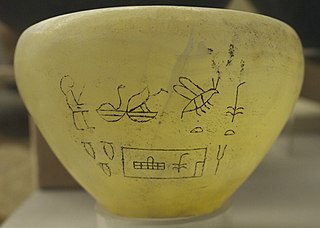
Khafra was an ancient Egyptian king (pharaoh) of the 4th dynasty during the Old Kingdom. He was the son of Khufu and the throne successor of Djedefre. According to the ancient historian Manetho, Khafra was followed by king Bikheris, but according to archaeological evidences he was rather followed by king Menkaure. Khafra was the builder of the second largest pyramid of Giza. The view held by modern Egyptology at large remains that the Great Sphinx was built in approximately 2500 BC for Khafra. There is not much known about Khafra, except the historical reports of Herodotus, writing 2,000 years after his life and who describes him as a cruel and heretic ruler, who kept the Egyptian temples closed after Khufu had sealed them.

Hetepheres II was a Queen of Ancient Egypt during the 4th dynasty.

Queen Meresankh III was the daughter of Hetepheres II and Prince Kawab and a granddaughter of the Egyptian pharaoh Khufu. She was the wife of King Khafre.
Nebemakhet was a king's son and a vizier during the 4th Dynasty. Nebemakhet was the son of King Khafre and Queen Meresankh III. He is shown in his mother's tomb and in his own tomb at Giza.

Kawab is the name of an ancient Egyptian prince of the 4th Dynasty. He was the eldest son of King Khufu and Queen Meritites I. Kawab served as vizier and was buried in the double mastaba G 7110 - 7120 in the east field which is part of the Giza Necropolis.
Khamerernebty II was an ancient Egyptian queen of the 4th dynasty. She was a daughter of Pharaoh Khafra and Queen Khamerernebty I. She married her brother Menkaure and she was the mother of Prince Khuenre.

Mindjedef was a Prince of ancient Egypt, who lived during the 4th Dynasty. His name means "Enduring Like Min". Min is an Egyptian fertility god.
Duaenre was a vizier under Menkaure during the Fourth dynasty of Egypt. His titles include those of king's son of his body, hereditary prince (jrj-pat), count (HAtj-a), vizier (tAjtj), scribe of the divine book, mouth of Nekhen, and mouth of every Butite.
Meresankh is the name of several royal women from the Old Kingdom in Ancient Egypt. It means "she loves life" and was popular during the 4th dynasty.
Hemetre (Hemetra) was an Ancient Egyptian royal woman of the Fourth Dynasty. Hemetre may have been a daughter or granddaughter of Khafre. She did not hold the title king's wife and may have even married a non-royal. She is mainly known from her tomb, which is located in the central field of Giza. Her name honors the god Ra.

The East Field is located to the east of Khufu's pyramid and contains cemetery G 7000. This cemetery was a burial place for some of the family members of Khufu. The cemetery also includes mastabas from tenants and priests of the pyramids dated to the 5th dynasty and 6th dynasty.

Raherka and Meresankh is a group statue of an ancient Egyptian couple of the 4th dynasty or 5th dynasty.

Women in ancient Egypt had some special rights other women did not have in other comparable societies. They could own property and were legally at court, equal to men. However, Ancient Egypt was a society dominated by men. Women could not have important positions in administration and were also excluded from ruling the country although there are some significant exceptions. Women at the royal court gained their position by the relationship to a male king.

The Nebty name was one of the "great five names" used by Egyptian pharaohs. It was also one of the eldest royal titles. The modern term "Two-Ladies-name" is a simple derivation from the translation of the Egyptian word nebty.









